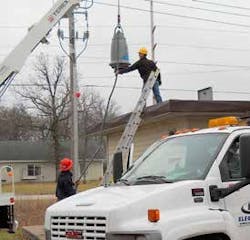Flygt N-Pump in Thief River Falls, MN
The collection system in Thief River Falls, Minnesota serves 8,500 residents. 14 pump stations are situated along 43 miles of sewage collection lines. The 350-acre complex of ponds in Northwest Minnesota represents the state’s largest of its type and produces a higher quality effluent well below the minimum effluent standards discharged into the Red Lake River.
Project Background
When Wayne Johnson, superintendent of water and wastewater utilities for Thief River Falls (TRF), began hearing the rhythmical thumping from Lift Station #9, he knew he had a problem.
Johnson initially hoped the clanging was nothing more than a partially clogged pump. Anything other than a clog could have left Lift Station #9 crippled and risk a bypass of 1.6 million gallons of raw sewage into the popular canoe and fishing stream that flows through the area.
The sound turned out to be emanating from one of two 75-hp submersible pumps the city had acquired from a German manufacturer four years earlier before Johnson had become superintendent.
“This was the second major problem with one of the pumps in two years of operation…the problem was further aggravated because of the manufacturer’s unresponsive customer service.”
The Lift Station was left vulnerable by relying on the German pump which began clogging as often as twice a week. The 1974-vintage pump was on its “last legs,” Johnson said.
Solution
Johnson turned to the office of Electric Pump, a factory-authorized representative for the Xylem Flygt brand of pumps that the utility has used exclusively in the other 13 stations along the collection system. A nationwide search by Electric Pump located two 80-HP Flygt Model N 3301 pumps in Atlanta that were immediately available but would require modest modifications for use in the dry pit versus a fully submersible installation.
The pumps feature Flygt’s patented “N” technology that delivers highly efficient, and clog-resistant, hydraulics.
The unique, semi-open impeller, combined with the relief groove in the volute, reduces the risk of clogging and allows passage of solids to maintain consistent pumping efficiency, even under high-solids conditions. This feature is important in handling the effluent off the local turkey and other meat processing plant.
The relief groove in the volute complements the self-cleaning impeller to maintain a consistent flow path through the pump. The concept eliminates most blockages and stringy material that can entangle a conventional impeller and induce energy-sapping drag that increases energy consumption.
Result
Electric Pump’s expedited delivery and installation resolved the station’s immediate vulnerability and prevented a potential nightmarish bypass once the first Flygt replacement pump became operational in 2012.
Because of the recurring blockages experienced with the remaining German pump, a second Flygt pump was procured and added to the station.
Editor's Note: Scranton Gillette Communications and the SGC Water Group are not liable for the accuracy, efficacy and validity of the claims made in this piece. The views expressed in this content do not reflect the position of the editorial teams of Water & Wastes Digest, Water Quality Products and Storm Water Solutions.
